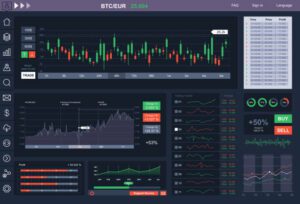Bitcoin Mining: An Overview
To understand the role of mining pools in Bitcoin mining, let’s begin with a brief introduction to Bitcoin mining itself.
Introduction to Bitcoin Mining
Bitcoin mining is the process of validating and adding new transactions to the Bitcoin blockchain. Miners utilize powerful computers to solve complex mathematical problems that secure the network and confirm transactions. In return for their efforts, miners are rewarded with newly minted bitcoins.
The Role of Mining Pools in Bitcoin Mining
As the popularity of Bitcoin grew, mining became increasingly competitive. Individual miners found it challenging to mine blocks on their own due to the high computational power required and the probability of successfully mining a block becoming lower over time. This is where mining pools come into play.
Bitcoin mining pools are groups of miners who combine their resources and computational power to increase their chances of successfully mining blocks. By pooling their resources, miners can collectively solve complex mathematical problems more efficiently and distribute the rewards among the participants based on their contribution.
Mining pools typically operate on a reward-sharing system, where the rewards are distributed among the miners based on the work they contribute to finding a block. This enables miners to receive consistent and predictable earnings, even if their individual mining power is relatively low.
Joining a mining pool allows miners to overcome the challenges associated with solo mining, such as the high upfront costs of mining equipment and the uncertainty of earning rewards. Mining pools provide a more accessible entry point for individuals interested in participating in Bitcoin mining.
To choose the right mining pool, miners should consider factors such as the pool size, hashrate distribution, fees, rewards structure, security, and reputation. Each pool may have different fee structures and payout mechanisms, so it’s important to evaluate these aspects before making a decision.
By joining a mining pool, miners can increase their chances of earning consistent rewards and contribute to the security and decentralization of the Bitcoin network. It’s important to note that while mining pools offer advantages, they also involve sharing rewards with other participants. Miners should carefully consider their options and select a reputable pool that aligns with their mining goals and preferences.
Now that we have explored the role of mining pools in Bitcoin mining, let’s delve deeper into what mining pools are and how they work.
What are Bitcoin Mining Pools?
To understand the concept of bitcoin mining pools, it’s important to grasp the definition and purpose of these pools, as well as how they function.
Definition and Purpose of Mining Pools
Bitcoin mining pools are collaborative groups of miners who combine their computational resources to increase their chances of successfully mining bitcoins. In a decentralized network like Bitcoin, mining is the process of validating transactions and adding them to the blockchain. Mining pools aim to improve the efficiency and profitability of individual miners by pooling their resources together.
The purpose of mining pools is to solve the challenge of mining bitcoins, which has become increasingly difficult over time. By working collectively, miners can combine their computing power, also known as hashrate, to solve complex mathematical problems more efficiently. This collaborative effort increases the chances of finding blocks and earning block rewards in proportion to each miner’s contribution.
How Mining Pools Work
Mining pools operate on the principle of shared rewards. When a mining pool successfully mines a block, the reward is distributed among the participating miners based on their hashrate contribution. The distribution is usually proportional to the amount of work each miner has contributed to the pool.
Here’s an example to illustrate how mining pools work:
- Miners join a mining pool and connect their mining hardware to the pool’s mining software.
- The mining pool assigns each miner a portion of the overall computational work required to mine bitcoins.
- Miners use their hardware to perform calculations and solve complex mathematical problems to validate transactions and secure the network.
- Once a block is successfully mined by the pool, the reward is distributed among the miners based on their contribution.
- The mining pool deducts a small fee from the rewards as compensation for operating the pool.
Mining pools allow individual miners to benefit from a more consistent and predictable income stream compared to solo mining. Additionally, miners with less powerful hardware can still participate and earn rewards by joining a pool with higher hashrate. However, it’s important to consider various factors when choosing a mining pool, such as pool size, fees, rewards structure, security, and reputation. For more information on considerations for choosing a mining pool, refer to our article on joining a mining pool.
Understanding the concept and functioning of mining pools is essential for bitcoin miners seeking to optimize their earnings and improve their chances of mining bitcoins in a highly competitive environment.
Advantages and Benefits of Mining Pools
Bitcoin mining pools offer several advantages and benefits to miners, making them a popular choice for those involved in cryptocurrency mining. Let’s explore some of the key advantages of joining a mining pool.
Increased Mining Efficiency
One of the primary advantages of mining pools is increased mining efficiency. When miners join a pool, they combine their computing power and resources, working together to solve complex mathematical problems and validate transactions on the Bitcoin network. This collaborative effort allows for a higher chance of successfully mining a block and earning the associated rewards.
By pooling resources, miners can collectively mine at a much higher hash rate than an individual miner could achieve on their own. This increased hash rate translates into faster block generation, increasing the chances of earning block rewards and transaction fees. Additionally, mining pools often utilize advanced mining hardware, further enhancing the efficiency and speed of the mining process.
Consistent and Predictable Earnings
Another significant advantage of mining pools is the consistent and predictable earnings they offer. When mining individually, the time between successfully mining a block and receiving rewards can be quite variable. This uncertainty can make it challenging to plan and predict earnings accurately.
In contrast, mining pools distribute rewards among participants based on their contributed hash power. This means that miners receive a portion of the rewards for every block mined by the pool, providing a regular and steady income stream. While the individual earnings may be smaller, the consistency and predictability of these earnings make mining pools an attractive option for miners seeking stability.
Access to Specialized Mining Hardware
Mining Bitcoin efficiently requires specialized hardware known as ASICs (Application-Specific Integrated Circuits). These devices are designed specifically for mining cryptocurrencies and offer significantly higher computational power compared to traditional CPUs or GPUs.
For individual miners, acquiring and maintaining this specialized hardware can be expensive and time-consuming. However, by joining a mining pool, miners gain access to the collective resources of the pool, including advanced mining hardware. This access allows miners to benefit from the increased hash rate and efficiency of these specialized devices without the need for a substantial upfront investment.
When considering the advantages and benefits of mining pools, it’s important for miners to carefully evaluate various factors such as pool size, fees, rewards structure, security, and reputation. For more information on joining a mining pool and getting started with Bitcoin mining, check out our article on how to start bitcoin mining.
Joining a mining pool can significantly enhance the mining experience, offering increased efficiency, consistent earnings, and access to specialized mining hardware. By leveraging the power of collective mining, miners can maximize their chances of success and optimize their earning potential in the world of Bitcoin mining.
Popular Bitcoin Mining Pools
When it comes to Bitcoin mining, joining a mining pool can significantly increase your chances of earning consistent rewards. Mining pools bring together the computational power of multiple miners, allowing them to collectively solve complex mathematical problems and share the rewards. Here are three popular Bitcoin mining pools:
Pool A
Pool A is one of the largest and most well-established Bitcoin mining pools in the industry. It boasts a high hashrate, which indicates the combined computational power of the miners in the pool. With a large pool size, Pool A offers miners a higher chance of successfully mining blocks and earning rewards.
| Pool | Hashrate |
|---|---|
| Pool A | 10,000 TH/s |
| Pool B | 5,000 TH/s |
| Pool C | 3,000 TH/s |
Pool B
Pool B is another prominent player in the Bitcoin mining pool scene. It has a significant hashrate and a sizable pool size, making it an attractive option for miners. Pool B has a reputation for reliable payouts and a user-friendly interface, making it a popular choice among both experienced and novice miners.
Pool C
Pool C is known for its competitive fee structure and consistent payouts. Despite having a slightly lower hashrate compared to Pool A and Pool B, Pool C maintains a strong reputation for its reliability and efficiency. Miners who prioritize low fees and consistent earnings often consider Pool C as a viable option.
When choosing a Bitcoin mining pool, it’s important to consider factors beyond just the hashrate. Factors such as pool fees, rewards structure, security, and reputation should also be taken into account. For more information on choosing the right mining pool, refer to our article on how to start bitcoin mining.
Joining a reputable mining pool like Pool A, Pool B, or Pool C can enhance your mining efficiency and provide you with consistent earnings. Remember to set up your mining rig correctly, choose and configure suitable mining software, and follow the pool’s instructions to get started on your Bitcoin mining journey.
Considerations for Choosing a Mining Pool
When it comes to choosing a mining pool for Bitcoin mining, there are several factors that should be taken into consideration. These factors can greatly impact your mining experience, efficiency, and profitability. Here are three important aspects to consider when selecting a mining pool: pool size and hashrate distribution, pool fees and rewards structure, and security and reputation.
Pool Size and Hashrate Distribution
The size of a mining pool and the distribution of hashrate among its participants are crucial factors to consider. A larger pool generally means a higher hashrate, which increases the chances of successfully mining blocks and earning rewards. However, larger pools may also lead to higher competition among miners. On the other hand, smaller pools may offer more consistent and predictable earnings, as the hashrate is distributed among fewer participants.
It’s important to find a balance that suits your mining goals and preferences. Some miners prefer the stability and reliability of larger pools, while others opt for smaller pools to avoid high competition. Analyzing the hashrate distribution of a pool can give you insights into its performance and potential rewards. You can also use a Bitcoin mining calculator to estimate your potential earnings based on the hashrate and block rewards.
Pool Fees and Rewards Structure
Mining pools usually charge fees for their services. These fees can vary among different pools and are typically deducted from the rewards earned by the miners. When selecting a mining pool, it’s important to consider the fee structure and how it may affect your overall profitability. Some pools have a fixed fee, while others may have a variable fee based on factors like the miner’s hashrate, payout frequency, or the number of shares contributed.
In addition to fees, understanding the rewards structure is crucial. Different pools may have different reward distribution methods, such as Pay-Per-Share (PPS), Pay-Per-Last-N-Shares (PPLNS), or Proportional. Each method has its own advantages and disadvantages, so it’s important to choose one that aligns with your mining goals and risk tolerance. Familiarize yourself with the specific details of the pool’s fees and rewards structure before making a decision.
Security and Reputation
The security and reputation of a mining pool are paramount. It’s essential to choose a pool that has a strong track record of reliability, security, and transparent operations. Look for pools that have been operating for a significant amount of time and have a positive reputation within the mining community. Online forums and communities can provide valuable insights and feedback from other miners.
Consider the security measures implemented by the pool to protect your mining earnings and personal information. Pools with robust security measures, such as two-factor authentication and SSL encryption, can help safeguard your assets and data. Additionally, reputable pools often provide regular updates, clear communication channels, and excellent customer support to address any issues or concerns that may arise.
By carefully considering the pool size and hashrate distribution, pool fees and rewards structure, as well as the security and reputation of a mining pool, you can make an informed decision that aligns with your mining objectives. Remember to stay informed about the latest developments in the mining industry and periodically reassess your choice of pool to optimize your mining experience.
Joining a Mining Pool
Once you have set up your mining rig and chosen the appropriate mining software, the next step is to join a mining pool. Joining a pool allows you to combine your computing power with other miners, increasing your chances of successfully mining new bitcoins. In this section, we will explore the steps involved in joining a mining pool.
Setting Up a Mining Rig
Before joining a mining pool, it’s crucial to have a properly functioning mining rig. This includes selecting and assembling the necessary bitcoin mining hardware and ensuring that it is compatible with your chosen mining software. Proper cooling and ventilation are also essential to prevent overheating and optimize the performance of your mining rig.
Ensure that you have a stable internet connection and a reliable source of power for uninterrupted mining operations. It’s also important to consider the electricity costs associated with mining and calculate the potential profitability using a bitcoin mining calculator. This will help you determine if mining is financially viable for you.
Choosing and Configuring Mining Software
Selecting the right mining software is crucial for efficient mining operations. There are several options available, each with its own features and compatibility requirements. Make sure to choose software that is compatible with your mining hardware and provides the necessary functionality for joining a mining pool.
Once you have chosen the mining software, you’ll need to configure it to connect to your chosen mining pool. This typically involves providing the pool’s server address, your unique worker credentials, and other relevant information. The mining software will use this information to establish a connection with the pool and start mining.
Joining a Pool and Getting Started
To join a mining pool, you’ll need to find a pool that suits your needs and has a good reputation within the mining community. Consider factors such as the pool’s size, hashrate distribution, fees, and rewards structure. It’s recommended to choose a pool that has a significant hashrate and a fair distribution of mining power.
Once you have selected a pool, sign up for an account and create a worker. A worker is a unique identifier that represents your mining rig within the pool. Configure your mining software with the worker credentials provided by the pool, ensuring that the software is set up to mine with the correct pool address and port.
After completing these steps, start your mining software, and it will connect to the pool. You will then contribute your computing power to the pool’s collective mining efforts. As blocks are successfully mined, the rewards will be distributed among the pool participants based on their contribution.
Joining a mining pool allows you to leverage the combined power of multiple miners, increasing your chances of earning consistent rewards. Remember to regularly monitor your mining operations, stay updated on any pool changes or updates, and adjust your mining strategies accordingly. Happy mining!





